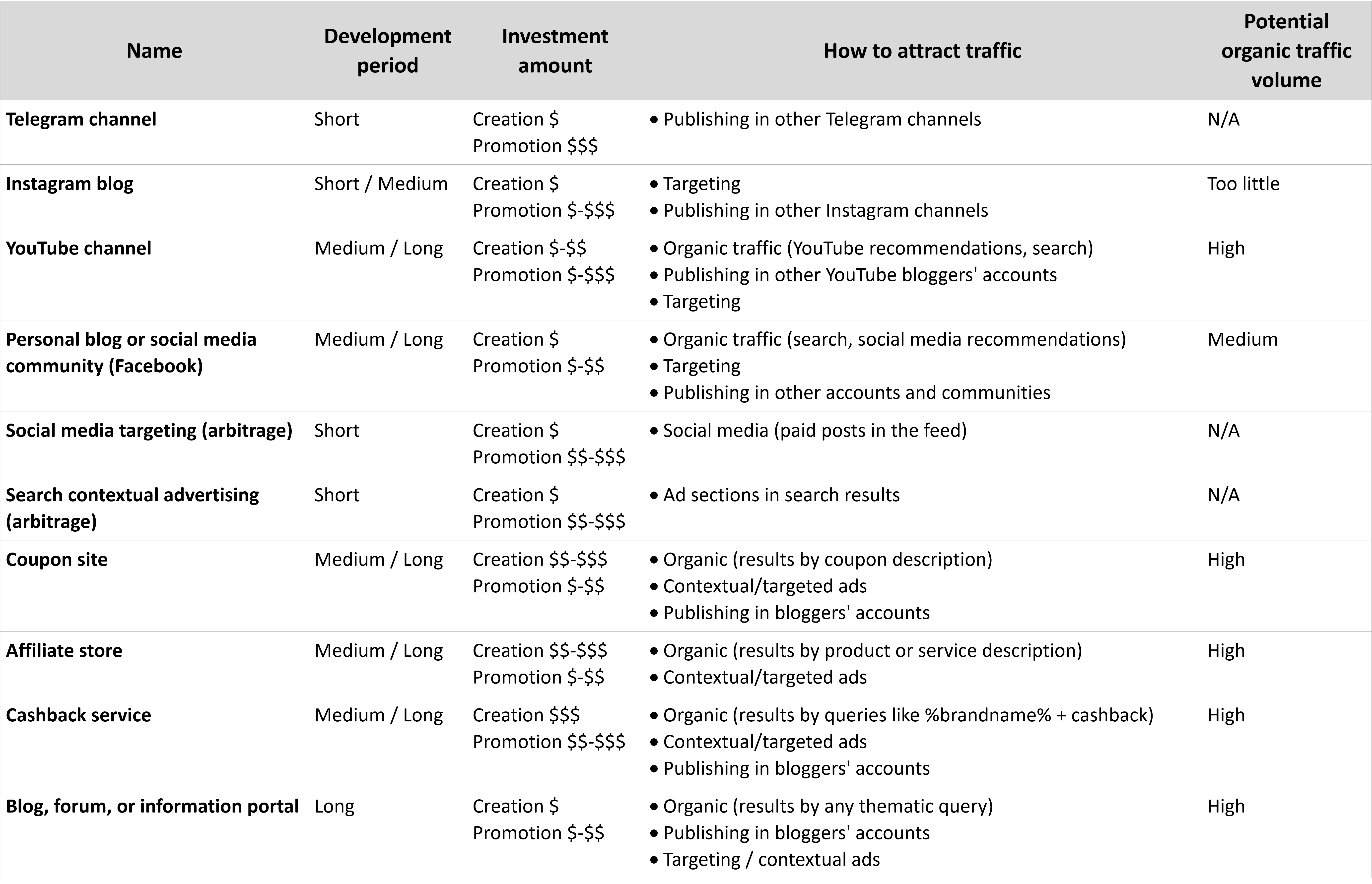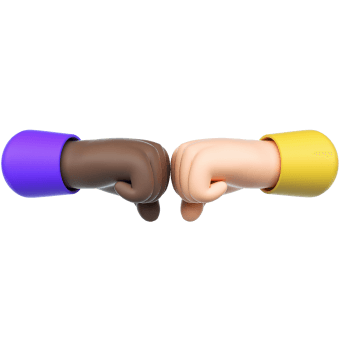TOP 10 business models: comparing and making an informed choice

If you are a newcomer to CPA marketing and stand at the parting of business models, take advantage of this instruction in which we have compared all the popular ad spaces and traffic types with their pros and cons. Let’s figure out what is longer, costlier, and more traffic-yielding.
For good reason, we don’t tell how much exactly you can earn with a business model or when it reaches a break-even point. In fact, there are numerous factors that affect your income (quality of creatives, investments in advertising, offer uniqueness, programs you choose) and your costs (what you do on your own, what you delegate to freelancers, whether you use paid or freemium traffic types).
!SPOILER ALERT! Everything you will read can only be helpful if you are ready to spend 2 hours to a whole day on self-education and developing your business model. Otherwise, even the “minimum investments” may turn into hundreds of thousands, and “one-month rapid start” with years of unprofitable work.
So, the guide features the following:
Also, you will find a brief comment on each of the following business models, (with parameter explanation):
- Telegram channel
- Instagram blog
- YouTube channel
- Personal blog or social media community
- Social media targeting (arbitrage)
- Search contextual advertising (arbitrage)
- Coupon website
- Affiliate store
- Cashback service
- Blog, forum, or information portal
Let’s get to it!
Business model comparison chart
Now let’s explore every parameter by which we appraised channels.
Channel comparison parameters
To compare the ad spaces, we will analyze the following parameters:
Development period
This parameter means how much time you will need to see traffic growth—in hundreds of subscribers, visitors, or clicks (i.e. the first traffic wave that will help you realize you’re doing right). It can be defined as a period within which you will see profit high enough to be withdrawn. We have divided the development period into three stages: short, medium, and long.
Short
You can get considerable traffic volume within a day (depending on the investment amount). Bottleneck: almost no organic traffic.
Medium
A month to half-year. Organic traffic requires more time. Paid channels (contextual and targeted ads, advertising partnerships with bloggers) can reduce this time. The bulk of time is spent on creating content, ad space design, optimization for search engines and/or ad space’s internal algorithms.
Long
A half-year to 1-2 years (growth is mostly ensured by organic traffic). For this time, an ad space gets indexed and promoted in search/ recommendations.
Investment volume
When calculating this parameter, we base on main costs—ad space creation (website development) and promotion. Also, we suppose an ad space owner will try to save money and make use of paid resources (outsourced traffic and contractors) as a last resort only.
$ (freemium)
Usually, there is an ad space (e.g. social media) or creating it requires minimum investments (CMS like WordPress, Tilda—all offering free themes and plugins). Search (organic) promotion available, which ensures almost free traffic.
$$ (medium)
There is a ready ad space but it requires investment in promotion (paid traffic) as there is little or no organic traffic.
$$$ (expensive)
No ready solutions (implies website development from scratch) and/or requires grand investments in advertising. The scope of investment may reach hundreds and thousands of dollars.
How to attract traffic
We don’t discover the continents again but resort to the most common methods. Sure, there are some cases when one publisher wore a T-shirt with an ad of their cashback service while another found out that new subscribers of their Telegram channel came after a radio ad. You must agree that such a case is an exception. So, stick to the cornerstone rule: primarily, source traffic from where your resource is located (search engines for websites, targeting and organic traffic for social media communities).
Potential organic traffic volume
This parameter stands between the “investment volume” and “traffic sources“. It’s always a pleasure to get free users who find and subscribe to you on their own. So, we have decided to separate this parameter.
Also, we have added the following parameters to analysis of all spaces:
- Commercialization tools. If you are going to monetize a space by means of CPA, you may want to take advantage of such instruments. We won’t tell you in details about every tool. After clicking the link, you will see a comprehensive instruction and decide for yourself whether one or another instrument can help you.
- What to read. Here, we will recommend you a few articles that will get you to the depths of every theme and let you learn more about one or another business model and analyze how to monetize a space with the help of CPA marketing.
Let’s look into each of the spaces.
Telegram channel
Development period:
- Short. You will get subscribers from other channels as long as they see your community’s ad in their feed. If you pay for advertising in 20 communities at a time, you will get subscribers from those communities within a day. After 24 hours of advertising, your post will disappear and you will have to purchase ads again.
Investment volume:
- Creation $. Creating a simple Telegram channels doesn’t require involving third-party developers. You can do it on your own with the help of the messenger interface and a couple of free bots. The process takes a half-hour.
- Promotion $$$. Telegram traffic is paid and costly. The price of one subscriber to a commercial channel (goods, discounts, coupon codes) varies from 20 to 50 rubles. On the other hand, subscribers to entertaining resources (e.g. a meme channel) cost less but yield lower—or no—sales.
How to attract traffic:
- Publishing in other channels. As there is no organic search in Telegram, a publisher will have to thoroughly select channels where to publish ads
Potential organic traffic volume (search traffic):
- N/A
Appropriate commercialization tools:
What to read:
Instagram blog
Development period:
- Short / medium. The bulk of the development period will be spent on filling the account up with quality content to retain user attention and make them subscribe. Then goes the advertisement’s turn, after which the audience will grow very fast (provided that the account is properly set, creatives are quality and budgets are sufficient).
Investment volume:
- Creation $. If we suppose everyone has a smartphone with a moderately good camera and access to an application store with free presets and editing tools, one will only need time and a couple of photography lessons to start.
- Promotion $-$$$. First, we brush aside bots as we only need human users. In this case, we have two subscriber sources that you can leverage concurrently: targeting and cross-posting with other bloggers.
How to attract traffic:
- Targeting
- Publishing ads in other accounts (exchanging audiences with same-scale bloggers, or paying mentions in more popular accounts)
Potential organic traffic volume (search traffic):
- Too little. Though hashtags, geotags, and comprehensive account description will bring you some organic subscribers, don’t think you will get too many. At best, this traffic category will hold a share of 5 to 10 percent of your followers.
Appropriate commercialization tools:
What to read:
YouTube channel
Development period:
- Medium/Long. Get ready to devote the lion’s share of time to content creation, including shooting, editing, music, tag and visuals selection, video description. If you rely on organic traffic (YouTube recommendations and search results on YouTube, Google, and Yandex), you will have to wait.
Investment volume:
- Creation $-$$. Creating videos is not as costly as it may seem. At initial stages, all you will need will include good illumination, a smartphone, clip mike, and video editor. If you realize your creatives catch users, you can think about employing higher-scale equipment.
- Promotion $-$$$. Here, it all depends on how quickly you want to get to a result. To ensure slashing-fast audience growth, you will have to invest in publishing in bloggers’ accounts and targeting. If you look for a budget-friendly solution, stay with organic traffic.
How to attract traffic:
- Organic traffic (YouTube recommendations, YouTube search, Google/Yandex search)
- Publishing in bloggers’ accounts
- Targeting
Potential organic traffic volume (search traffic):
- High
Appropriate commercialization tools:
What to read:
- How to create a business channel on YouTube
- To be or not to be an influencer on YouTube? Earning on YouTube
- Tools and services to analyze and optimize YouTube channel
- “You’ve got to have stars in your eyes, and you cannot fake that”, — blogger Elena Galant talks about making money on YouTube
Personal blog or social media community
Development period:
- Medium / Long. Content creation will take much time. But, proper targeting may provide you with the first hundred users in a day. If you want to only use organic traffic to develop your blog or community, you will have to wait for long. You will have to wait for a long time until it notices your content.
Investment volume:
- Creation $. If you are ready to do all that on your own, it will cost you nothing to create and design a community, and compose posts. All you will need is time.
- Promotion $-$$. The price of a subscriber to a community or blog is not very high — no matter whether you use targeted ads or publish ads through community admins.
How to attract traffic:
- Organic traffic (search, social media recommendation)
- Targeting inside social media
- Publishing in other accounts and communities
Potential organic traffic volume (search traffic):
- Medium
Appropriate commercialization tools:
What to read:
- Affiliate marketing through social media
- Facebook for affiliate marketing
- Promotion through Facebook page
Social media targeting (arbitrage)
Development period:
- Short. In arbitrage, traffic is being driven as long as a campaign’s balance is positive. There are not traffic volume limits. The only limit is your budget. Want to drive a hundred leads in a day? You’re clear to go.
Investment volume:
- Creation $. It’s free to use an advertising account on social media, so creating an ad campaign will cost you nothing.
- Promotion $$-$$$. but, if we speak of promotion, be ready to waste some of your budget funds during tests. For good reason, arbitrage is considered one of the most profitable and costly business models.
How to attract traffic:
- Social media (paid posts in the feed). Create an advertising account and see what ad formats are available.
Potential organic traffic volume (search traffic):
- N/A (targeting means promotion by audience features rather than its queries, in contrast to SEO and contextual advertising)
Appropriate commercialization tools:
What to read:
Search contextual advertising (arbitrage)
Development period:
- Short. Just like in targeted advertising (as well as any other type of arbitrage), you will get clicks almost instantly. But make sure you set up your campaign correctly.
Investment volume:
- Creation $. Google Ads and Yandex.Direct offer free tools to launch contextual advertising campaigns.
- Promotion $$-$$$. Just as in targeting, traffic volume and campaign duration directly depend on the amount of funds invested. The more you spend and more properly use, the better the result. But, budgets start from hundreds of dollars so gear up your accounts.
How to attract traffic:
- Ad sections in search results
Potential organic traffic volume (search traffic):
- N/A. Don’t forget that, though contextual ads are search ads, you get paid rather than organic traffic.
Appropriate commercialization tools:
What to read:
Coupon website
Development period:
- Medium / Long. The bulk of time effort will be spend on creating a website, designing it, and setting up automatic coupon updates.
Investment volume:
- Creation $$-$$$. So far, there is no out-of-the-box solution for exporting coupons to a website, so you will have to design your website and automate coupon updates by yourself. Lifehack: leverage a White Label by publishing a coupon store on your website (e.g. information portal). But, in this case, you will have to share your income with creators.
- Promotion $-$$. There are lots of coupon stores in the market. You won’t make it only with organic traffic so you’ll have to spend some funds on promotion.
How to attract traffic:
- Organic (results by coupon description and queries like %brandname% + discount)
- Contextual and targeted advertising
- Publishing in bloggers’ accounts
Potential organic traffic volume (search traffic):
- High
Appropriate commercialization tools:
What to read:
- 10 types of websites to earn with affiliate marketing (CPA)
- How publishers see the affiliate partnership by CashKaro.com
Affiliate store
Development period:
- Medium / Long. Just like in case of a coupon store, you will need some time to create a store with a handy heading list and promote your store in a highly-competitive environment.
Investment volume:
- Creation $$-$$$. As with coupons: there is no ready solution to export and update your offers, so you will have to invest in development on your own or take advantage of a White Label solution.
- Promotion $-$$. Organic traffic will help you but you will still need context ads to reinforce your success.
How to attract traffic:
- Organic (results by product and service description)
- Context and targeted advertising
Potential organic traffic volume (search traffic):
- High
Appropriate commercialization tools:
What to read:
- Creating a successful affiliate store: case of LaSuper Ukraine
- Online store, affiliate store, dropshipping service: what’s the difference?
Cashback service
Development period:
- Medium / Long. Similar to affiliate an coupon stores, there is no ready solution. You will have to design one by yourself.
Investment volume:
- Creation $$$. Beside a store, you will have to integrate a payment service for withdrawal, set up a support service to handle questions like “Where is my cashback? Why is it so low and when will it be credited?” Add promotion costs to that and you’ll see a hefty amount.
- Promotion $$-$$$. You can’t make it with organic traffic only. There are a few major market players, so you will have to invest much in promotion to capture a niche.
How to attract traffic:
- Organic (results by queries like %brandname% + cashback)
- Context and targeted advertising
- Publishing in bloggers’ accounts
Potential organic traffic volume (search traffic):
- High
Appropriate commercialization tools:
What to read:
Blog, forum, or information portal
Development period:
- Long. Mostly, bloggers promote their accounts with the help of organic results, but it needs time. Quality content will give you medium-high user base growth—5-15% per month (high in relative terms but may be insufficient in absolute terms.
Investment volume:
- Creation $. You can create a free blog on WordPress or Tilda, but you will have to spend some money on domain and hosting (though this amount is affordable even for students). If you want so, you can buy plugins with extended functionality or designer’s themes. But, practice shows such tricks can’t improve search ad results (provided that your content is good enough).
- Promotion $-$$. A resource owner can use any paid traffic sources if they need to expand the audience quickly (for instance, before 11.11 or Black Friday). However, most bloggers prefer freemium traffic.
How to attract traffic
- Organic (results by any theme query)
- Publishing in bloggers’ accounts
- Targeting / contextual ads
Potential organic traffic volume (search traffic):
- High
Appropriate commercialization tools:
What to read:
- Oh my Blog! How to make money in CPA with a blog?
- Review of content types
- 10 types of websites to earn with affiliate marketing (CPA)
What business models are not covered in this article but have potential? Please tell us your opinion in comments and share your experience in creating ad spaces.








how about blogger is it like wordpress if iam beginner how to start with you